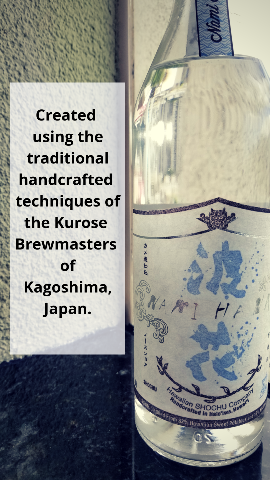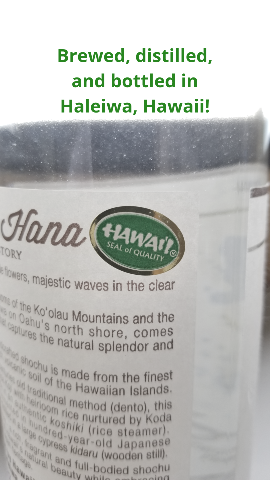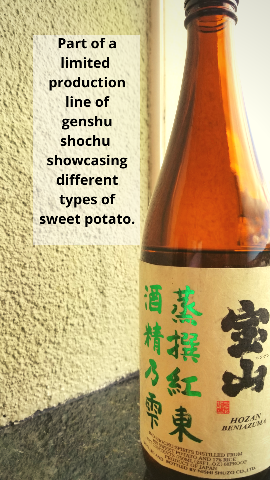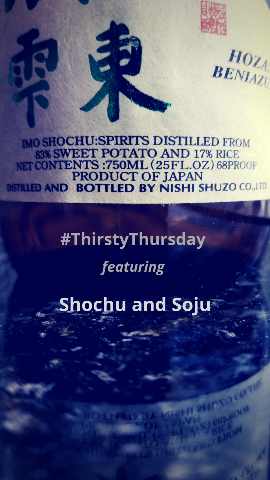What is Shochu?
Shōchū is a Japanese distilled beverage less than 45% alcohol by volume. It is typically distilled from rice (kome), barley (mugi), sweet potatoes (satsuma-imo), buckwheat (soba), or brown sugar (kokutō), though it is sometimes produced from other ingredients such as chestnut, sesame seeds, potatoes or even carrots.
Typically, shōchū contains 25% alcohol by volume, which is weaker than whisky or standard-strength vodka but stronger than wine and sake. It is not uncommon for multiple-distilled shōchū, which is more likely to be used in mixed drinks, to contain up to 35% alcohol by volume.
Interestingly, the word shōchū is the Japanese rendition of the Chinese shāojiǔ; literally meaning "burned liquor".
Shōchū should not be confused with sake, a brewed rice wine. Its taste is usually less fruity and depends on the nature of the starch used in the distilling process. Its flavor is often described as "nutty" or "earthy".
Shōchū is drunk in many ways according to season or personal taste: neat,with nothing added, on the rocks, diluted with room temperature water (mizuwari) or hot water (oyuwari), mixed with oolong tea or fruit juice, as chūhai, a mixed drink consisting of shōchū, soda, ice and some flavoring, often lemon, grapefruit, apple or ume or mixed very cold with a beer-flavored beverage known as hoppy (think boilermaker).
In Kyūshū, the center of production, shōchū is far more common than sake. Indeed, here sake generally means shōchū, and is normally consumed mixed with hot water. First hot water is poured into the glass, then shōchū is gently added. The liquids mix naturally and stirring is unnecessary. Typically, the amount of shōchū exceeds the amount of hot water, and is enjoyed for its aroma. Occasionally, shōchū and water are mixed, left to stand for a day, and then gently heated.
Namihana is a distilled spirit made with Hawaii’s beautiful nature and Japan’s traditional craftsmanship. Namihana is a premium Hawaiian Imo (sweet potato) Shochu brewed, distilled, and bottled in Haleiwa, Hawaii.
Namihana is created with the traditional handcraft techniques of “Kurose Brew Masters” of Kagoshima, Japan. The rice is steamed in a wooden steamer called Koshiki, then it is cultured to make Koji-rice.
The mash of Koji-rice and steamed sweet potatoes is slowly and naturally fermented in the century-old ceramic vats called Kametsubo. Namihana is distilled only one time with the traditional wooden still called Kidaru.
Hawaii’s year-round warm climate is similar to Kagoshima’s fall season when Imo Shochu is produced. The soil condition greatly influenced by the volcanic activity is ideal to grow quality sweet potatoes. Also, the sweet potatoes are considered a traditional crop in Hawaii, with over twenty varieties of sweet potatoes grown.
Distiller’s Profile: Ken served his apprenticeship under Master Manzen at Manzen Shuzo Co. in Kagoshima, Japan. Manzen Shuzo Co. is a well-known for their traditionally handcrafted premium Imo Shochu. Ken was able to learn the techniques of “Kurose Brew Masters” from Master Manzen. Ken and his wife Yumiko started their small distillery in Haleiwa, Hawaii in 2013.
Hozan Beniazuma Imo Shochu
Nishi Shuzo’s Hozan Beniazuma is part of a limited-production line of genshu shochu showcasing different types of sweet potato. Besides Beniazuma imo, they also bottle an Ayamurasaki and a Shiroyutaka-based imo. All run 34% ABV with basically the same distillation specs.
Beniazuma Hozan is rich, spicy, and contemplative. It’s great neat, but also shows well on the rocks and as mizuwari. Serve with rich-flavored dishes. It pairs particularly well with pork and chicken-based cuisine.
Mash: Imo 83%, Kojimai 17% (rice) Koji: Kuro (black)
Imo Type: Beniazuma Distillation: Honkaku (once distilled) ABV: 34%, Genshu
-- Kerry Ichimasa, Assistant Wine Director




